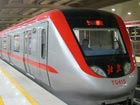| Videos | • Latest |
|
• Feature | • Sports | • Your Videos |
New subway lines ease traffic pressure in Beijing

To ease increasingly difficult traffic pressures on the road, Beijing is investing heavily in its subway network.
The city's streets are becoming more and more congested.
Commuting between work and home has become a daily torment, especially for people living in the suburbs.
A Beijing driver said, "I can't recall a day without jams."
But the recent completion of five new subway lines may make their life a little easier.
A passenger said, "I had to get up at 5 am and then take the bus to Xidan. It usually took two hours. Now taking the subway cuts the time nearly in half."
The five lines opened on December 30th, adding 108 kilometers to the capital's metro rail network. Each of these new routes connects existing lines to the surrounding suburbs.
At Songjiazhuang Station, transferring from Line 5 to the newly opened Yizhuang Line takes less than one minute.
Tao Ran, chief of JIugong Station,said, "During the rush hours, 3,000 people enter the station each hour. We will arrange additional staff at key positions to make sure the passengers get on and off safely."
In 2010 alone, Beijing invested 15 billion yuan to subsidize surface and underground public transportation systems. At least 100 million people have travelled though the newly opened lines. Park-and-Ride facilities are also being constructed so people living in the suburbs don't have to drive into downtown areas.
Beijing authorities are planning to add another 10 subway lines by 2015. The subway network will be extending some 700 kilometers, which equals to 3 round trips from Beijing to Tianjin. The aim, authorities say, is to create a city where people don't have to drive.
 0
0 







Go to Forum >>0 Comments